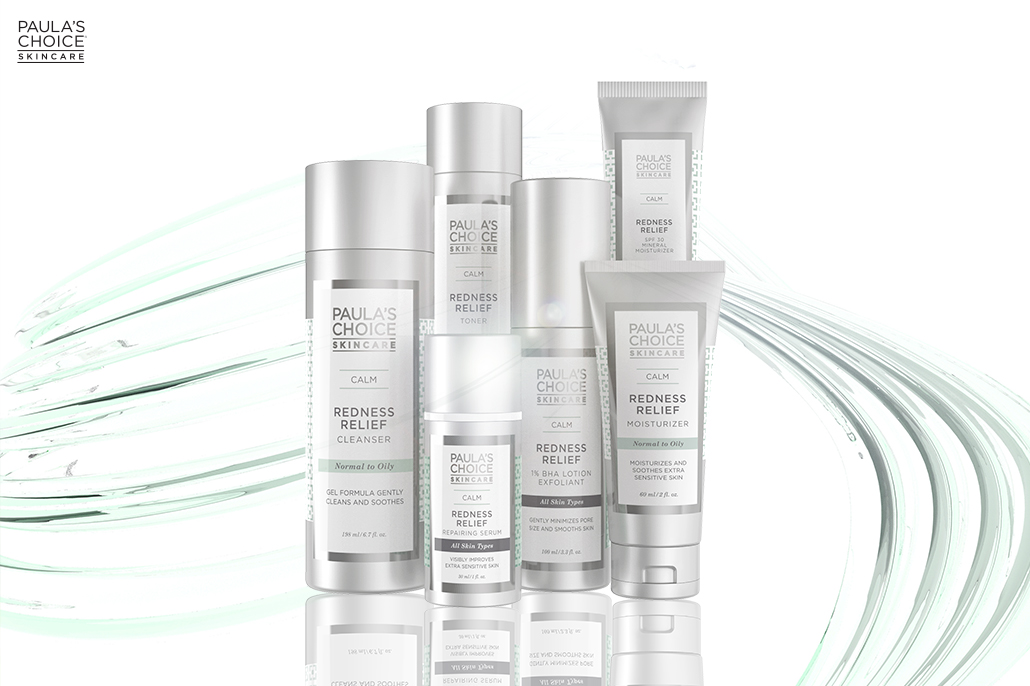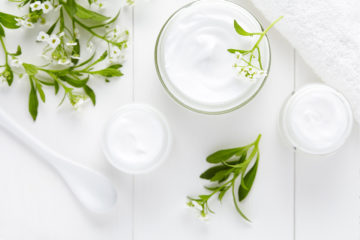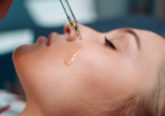Ceramides: The Newest Anti-Aging Superstar?

Article Index:
What are Ceramides? > How Do We Lose Ceramides? > Types of Ceramides > How to Replenish Ceramides? > Ceramides for Skin Conditions > Introducing Our New Ceramide-Enriched Moisturizer
What are Ceramides?
Ceramides are naturally occurring, fatty parts of the skin’s outer protective layer. Also known as a lipid (fat), ceramides make up about 50% of the skin’s natural barrier system – along with cholesterol and other free fatty acids.
In its essence, the skin’s natural barrier prevents moisture loss and protects it from external environmental damage. The function of ceramides in this is to act like a ‘glue’, holding the barrier system together.
When there is a loss of ceramide content or production in the skin, our natural barrier gets weaker. This means that it would be harder for the skin to retain its moisture, which can then lead to dehydration, sensitivity, roughness, wrinkles, redness, and/or irritation.
Ceramides are a well-researched group of skin-identical ingredients but have only recently risen to prominence alongside other popular ingredients such as Retinol and Vitamin C.
This could be due to more recent research which shows that ceramides, beyond its anti-aging benefits, can also help with those who are battling skin-issues such as Acne and Eczema. Another possible factor is that with improved manufacturing processes, the cost of incorporating ceramides into modern formations has been considerably reduced.
Ceramides vs. Hyaluronic Acid
It’s a common misconception that ceramides and hyaluronic acid perform the same function – they both moisturize the skin. However, these two ingredients work in fundamentally different ways.
Hyaluronic acid is considered to be a humectant. Humectants are ingredients which attract and ‘pull’ water. When hyaluronic acid is used on the skin, it ‘pulls’ water from both the atmosphere and from the lower layers of the skin, to hydrate the upper layer of skin. This gives the skin an almost instant supple, bouncy, and hydrated feel.
Ceramides, however, work more like occlusives, but are not technically considered as one. Occlusive ingredients work by preventing moisture loss, but topically applied ceramides don’t technically prevent moisture loss in and of itself. Instead, it helps to replenish the ceramide content in skin, which strengthens the skins’ natural barrier that prevents moisture loss.
How Do We Lose Ceramides?
Typically, we lose ceramide content in our skin as we age and when our skin is exposed to sun damage. That’s part of the reason why all of us here at Paula’s Choice are such big proponents of sunscreen. As we age, the skin loses its ability to naturally produce ceramides, and this typically starts to happen in our 30’s.
Research has correlated the level of estrogen and ceramide in the skin. Estrogen therapy has shown to increase skin’s content of collagen, ceramides, and hyaluronic acid – all of which helps to maintain skin thickness and the natural barrier function. This means that when estrogen levels drop – especially for women in their 50’s when they experience menopause, their ability to produce ceramides and maintain the skin barrier is reduced.
While the level of ceramides will decrease as we age, the ratio of different ceramides to one another would relatively stay the same for those with healthy skin. Besides natural aging and hormonal changes, the level of ceramides in our skin is also affected by some skin conditions. Those who suffer from dermatitis, acne, and psoriasis have lower levels of ceramides, and an altered ratio of ceramides when compared to those with healthy skin.
Replenishing the ceramides your skin has lost and can no longer create for itself will absolutely help skin visibly behave as it once did.
Types of Ceramides
The ceramides used in skincare products are can be made from plants, but most are synthesized. While there is no research showing that either form is better or safer over the other, synthetic ceramides are typically used because chemists can control the chain length of synthesized ceramides, and not organically derived ceramides. The benefit of this is the potential to make it a ‘better fit’ for specific skin cells in need of help.
There are at least 9 types of Ceramides and two main ceramide precursors. Because there has been a change in the names of ceramide ingredients, you may occasionally see ceramides listed numerically as well.
- Ceramide EOS (Ceramide 1)
- Ceramide NG (Ceramide 2)
- Ceramide NS (Ceramide 2)
- Ceramide NP (Ceramide 3) : The most common type found in skincare formulations
- Ceramide EOH (Ceramide 4)
- Ceramide AS (Ceramide 5)
- Ceramide AP (Ceramide 6)
- Ceramide NH (Ceramide 7)
- Ceramide AH (Ceramide 8)
- Ceramide EOP (Ceramide 9; Ceramide I; Ceramide IA)
- 2-oleamido-1,3-octadecanediol : Plant-derived ceramide commonly found in skincare and hair care products as a conditioning agent.
There are also two particular ceramide precursors which you should pay attention to:
- Phytosphingosine (e.g. Caprooyl Phytosphingosine)
- Sphingosines (e.g Hydroxypalmitoyl Sphinganine, or Caproyl Sphingosine [Ceramide 6 II])
Instead of simply restoring the ceramides lost in the skin, ceramide precursors help the uppermost layer of skin to produce more ceramides. Formulas using these precursors are very promising in delivering additional anti-aging benefits. Thankfully today, consumers have access to a wide range of skincare products with ceramides. And what’s better is that as ceramides become more recognized, you wouldn’t have to dive into the ingredient list to hunt down if a product has them. Most of the time, brands would prominently label and advertise ceramides on their products.
That being said, while ceramides are awesome for skin, it should not be seen as a magical ingredient to solve all your problems. A good product should be formulated with a whole host of other beneficial ingredients. It needs to treat your skin gently while also giving your skin other essentials which it also needs – such as antioxidants.
How to Replenish Ceramides?
Replenishment of ceramides in the skin helps to normalize or accelerate barrier recovery and keep its appearance firm and plump. Good news is that there are a couple of ways you can approach ceramide replenishment:
Topically
Ceramide-containing creams have been shown to be effective in restoring skin integrity, which will help with roughness, elasticity and all the other markers of youthful skin. Since ceramides are naturally a part of your skin, it ideal for all skin types—even for those with extra sensitive, breakout-prone, or oily skin. They’re also safe to use around the eyes!
Ceramides are most effective when combined with other skin-replenishing ingredients like fatty acids, glycerin, and cholesterol. We also recommend the use of a gentle leave-on AHA or BHA exfoliant which helps to keep the uppermost layer of skin clear of dead skin. This then allows your ceramide-enriched product to be better absorbed and be more effective. Furthermore, Lactic Acid (a type of AHA) can increase the production of ceramides in the skin – similar to ceramide precursors.
If you’re looking for a more affordable way to boost your skin’s ceramide levels, do consider Niacinamide too. It has been shown to increase ceramide and free fatty acid levels in the skin – helping to repair that all important protective barrier.
Orally
Ceramides are naturally occurring and can be found in many food sources, but mainly in plants. These are typically referred to as Phytoceramides. Today you can find ceramide vitamins and supplements derived from wheat, beet, and most commonly: rice. Research has shown that orally ingested supplements can improve skin hydration levels.
Dairy, eggs, and soybeans also contain large amounts of sphingolipids. As mentioned previously, sphingolipids (e.g. sphingosine) helps skin to produce more ceramides.
While you can easily get ceramides from food due to its abundance, it would not be sufficient if you’re looking to rejuvenate aging skin. However, you don’t need to take ceramide supplements to maintain a healthy diet.
Ceramides for Skin Conditions
Research has demonstrated that skincare formulations containing lipids identical to the skin, such as ceramides, may improve disturbed skin conditions.
Acne
In acne-affected skin, the barrier function is impaired. This causes a reduction in skin surface lipids (ceramides), which leads to a decrease in skin’s ability to retain moisture. For those with acne, the ceramide precursor phytosphingosine, in particular, is depleted. The impaired skin barrier leaves the skin more vulnerable to inflammation and infection, leading to the formation of comedones.
Ceramides-enriched skincare products are not typically prescribed as a treatment for acne. Instead, moisturizers with ceramides and other ceramide-based supplements are a great way to complement traditional acne treatment.
Traditional treatment of acne by using leave on acid exfoliants, benzoyl peroxide, and Retinol, can cause dryness and skin irritation. Ceramides use in conjunction with acne therapy is meant to be used to reduce irritation, inflammation, and dryness. Not only will it give relief, but it should result in quicker improvement of acne by its treatment. Furthermore, ceramides will help accelerate the repair of the skin’s barrier, giving your skin a better ability to resist external environmental attack which can result in pimple formation.
If your acne is very severe, or persistent, we would recommend a visit to a dermatologist.
Atopic Dermatitis (Eczema)
Sufferers of eczema have skin which is easily irritated and appears to be dry. An increase in transepidermal water loss (TEWL) – the process where the body loses water through the topmost layer of skin, and an overall decrease in skin hydration, points to a weakened barrier system.
For those who suffer from eczema, this weakened barrier system is caused mainly by ceramide loss and the imbalance of the ratio of ceramides in the skin. For atopic skin, Ceramide EOS (CER 1) has the most significant loss. However, TEWL is mostly linked to the loss of Ceramide NP (CER 3).
The good news is that topical skincare is an option for those with mild to moderate eczema to help with the symptoms. Look out for non-fragrant, gentle, liquid cleansers and moisturizers with ceramides in the formula.
Psoriasis
Psoriasis is a genetic and chronic skin condition which is caused by overproduction and overabundance of skin cells. This results in scaly and flaky skin, with redness – typically around the elbows, knees, and scalp. However, its symptoms can manifest in any part of the body. In addition, psoriasis creates a defective skin barrier. Compared to normal skin, those with psoriasis have lower levels of Ceramide NP (CER 3), Ceramide AP (CER 6), Ceramide EOS (CER 1), Ceramide EOH (CER 4), and Ceramide AS (CER 5)
While psoriasis has no cure, skincare is a viable solution to help mitigate and manage its symptoms. We recommend, however, consulting with a medical professional before trying to treat it yourself. Treatment for Psoriasis usually includes many other products and ingredients, and a qualified professional is able to get you the best suitable treatment.
Xerosis and Pruritus (Dry and Itchy Skin)
Xerosis (dryness) and Pruritus (itchiness) exist in 30%-75% of senior adults and typically worsens with advancing age. These are the medical names of the phenomena where older adults can see a shift of skin type towards one that is drier, which can also cause itchiness.
A 15-day study conducted with volunteers of 60-73 years old showed improved visual dryness when they used a moisturizer containing ceramides at least once daily. It also improved their quality of life, as pruritus (itchiness) can cause impaired sleep, and further skin damage when scratched.
From this study, we can extrapolate that on top of choosing the appropriate texture of products for your skin type, those with drier skin can easily see further benefits by incorporating ceramides in their daily skincare routine.
Introducing Our New Ceramide-Enriched Moisturizer
For more of our products with ceramides, click here (Singapore), or here (Malaysia)














